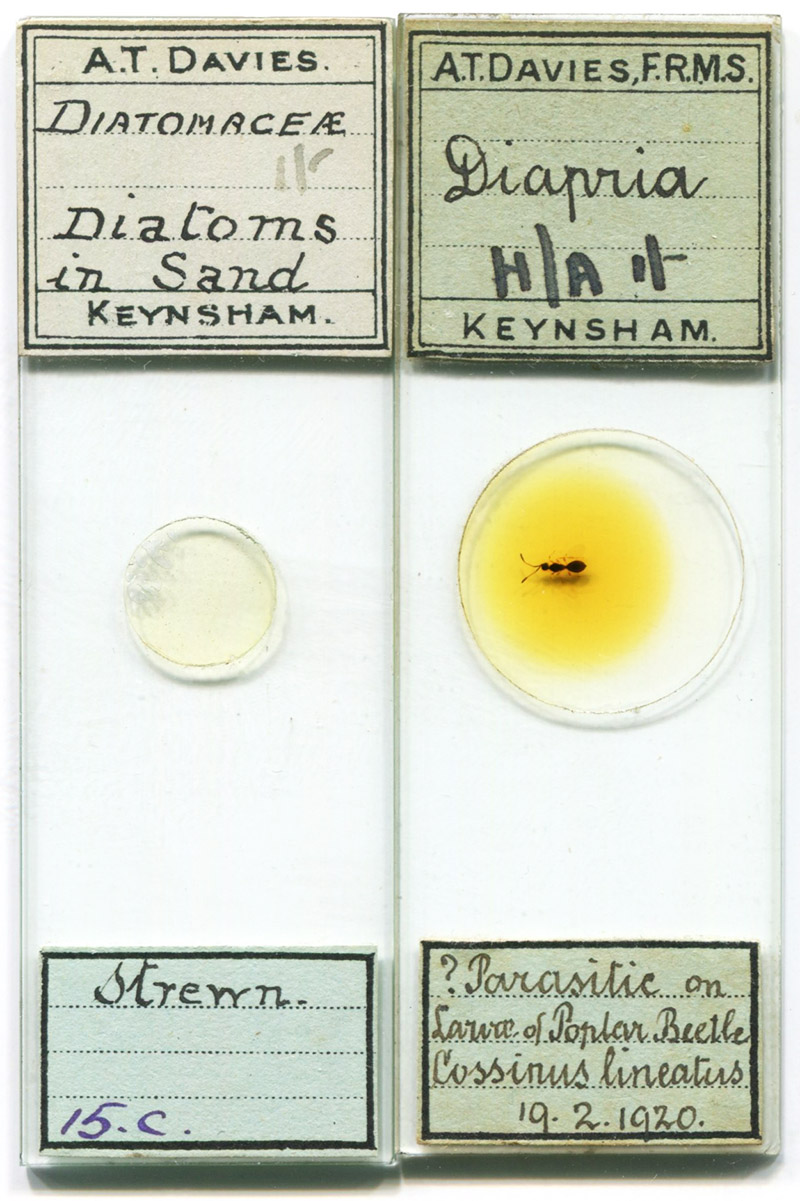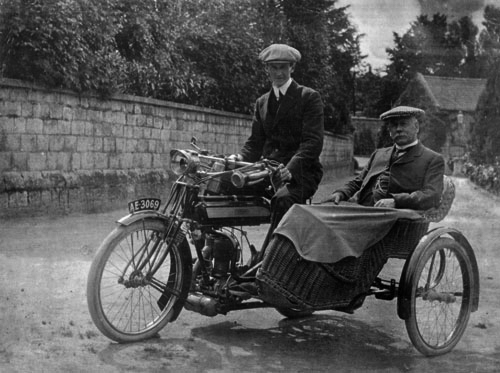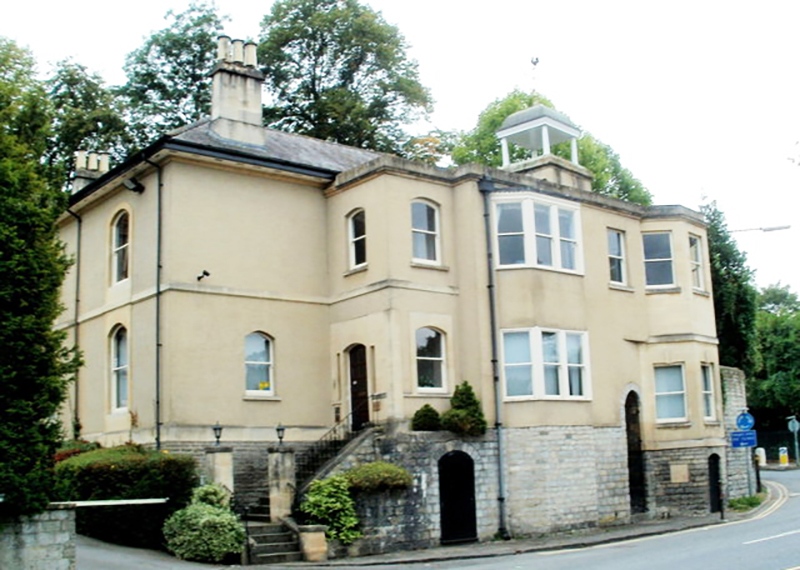Alfred Thomas Davies, 1850 - 1934
by Brian Stevenson
last updated December, 2020
A.T. Davies was an important driver of amateur microscopy in the Bristol, England area during the early 1900s. He was a member and officer of the Bristol Microscopical Society and the Bristol Naturalists’ Society, and became a Fellow of the Royal Microscopical Society in 1916.
A colleague wrote that Davies “was a master mounter and constantly exhorted the members to mount for themselves. Neatness and cleanliness were a sine-qua-non to Mr. Davies and he applied these same high standards to our mounting. His candid and fearless, yet kindly criticisms, were most helpful to all who, like myself, were privileged to associate with him”.

Figure 1.
Microscope slides by Alfred T. Davies. Slides are regularly seen with his custom-printed labels that either do or do not include mention of his membership in the Royal Microscopical Society (F.R.M.S.). Davies became a Fellow of the RMS on May 17, 1916, which helps date his slides. The example on the right bears the handwritten date of February 19, 1920.

Figure 2.
A 1925 photograph of A.T. Davies (in the sidecar), with his son Alfred Cecil Vian Davies (on the motorcycle). They are posed outside their home of Avon House, in Keynsham. Adapted for nonprofit, educational purposes from https://www.saltfordenvironmentgroup.org.uk/history/history005-20C.html, Tony Coverdale of the Saltford Brass Mill Project.
Alfred Thomas Davies was born in Saint Agnes, Cornwall, and christened at the parish church on December 7, 1850. He was the third child, and second son, of John and Mary Davies. Father John was listed on census records as being a “tin mine agent” and “mining engineer”. Alfred’s elder brother, John Jr., followed their father into the mining business, while Alfred took a different tack, being listed in the 1871 census as a “merchant’s clerk”.
Alfred married Esther Elizabeth Vian in late 1879, in Plymouth. The marriage probably coincided with his move to Keynsham, Somerset to manage a brassware manufacturing plant. They had two children, Alfred Cecil Vian Davies (in 1881) and Ethel Beatrice Davies (in 1884). Esther died on November 18, 1892, when only 37 years old.
Initially, the Davies boarded with a widow on High Street, Keynsham. They would not move into the mansion-like Avon House until after the turn of the century. That home, with its expansive gardens along the River Avon, was associated with the brass mill, and was occupied by the mill’s owners until the early 1900s.
A microscopy club, initially named the Bristol Y.M.C.A. Microscopical Society, formed in 1905, and Davies later became President. Colleague H.M. Hatherly wrote of Davies, “His home, Avon House, Keynsham, set in a charming old world garden, was open to fellow microscopists. … Surrounded by most types of microscopical life on his own premises, Mr. Davies was to be envied, but he was most liberal with it all. An interest in microscopy was an ‘open sesame’ at any time to Avon House. Once a year the Society paid a ‘state visit’ to his home. We were given free access to the gardens invited to pick and take away as many flowers as we liked. Many rare and beautiful botanical specimens existed in the garden. We were given tea on the lawn in fine weather and treated to a microscopical address by the president and host, often on some find by one of the members in the garden that afternoon. Miss Daisy Davies and Mr. Cecil Davies assisted their father in making this annual fixture something to look forward to with keen pleasure”.
Davies was also a long-term member of the Bristol Naturalists' Society. He was elected to the Royal Microscopical Society on May 17, 1916.
I did not find records of Davies advertising to exchange specimens or slides. It may well be that his society contacts met his needs. I did find one microscopy-related exchange request, from 1921, “Wanted, a Petrological Microscope, with or without objectives - Davies, Avon House, Keynsham, Bristol”.
The brass mill was primarily powered by water (Avon House was located alongside the mill pond), and was described as using “eighteenth-century methods of producing brass hollow-ware vats and pans”. A the twentieth century turned, the mill operated “spasmodically” and “employment at the brass mills was no longer secure”. The First World War brought a demand for shell casings, but production fell off soon after the war’s end. Davies purchased the business in 1925, but closed it in 1927. He ceased his membership in the Bristol Naturalists’ Society at that time, probably due to the demands of trying to rescue a dying business.
Alfred died on January 28, 1934. The probate of his will described him as “retired brass manufacturer” with an estate of over £6600, so he evidently managed a good life after his mill closed.

Figure 3.
A modern view of Avon House, now used for offices. Adapted for nonprofit, educational purposes from https://www.geograph.org.uk/photo/3085417
Resources
Bracegirdle, Brian (1998) Microscopical Mounts and Mounters, Quekett Microscopical Club, London, pages 29 and 128, and Plate 12P and 12-Q
Day, Joan (1990) Work, in Keynsham and Saltford: Life and Work in Times Past, 1539-1945, Ed by Elizabeth White, Keynsham and Saltford Local History Society, pages 19-39
England census and other records, accessed through ancestry.com
English Mechanic and World of Science (1921) Exchange offer from A.T. Davies, page 150
Hatherly, H.M. (1958) A short history of the Bristol Microscopical Society, The Microscope, pages 251-252
The History of Saltford: Online Museum (accessed December, 2020) 20th Century, page 1, Buildings & Roads, Transport “Pictured here in 1925 is the last owner of Saltford Brass Mill, Alfred Thomas Davies (in sidecar), with his son Alfred Cecil Vian Davies (on motorbike). The photograph is taken outside Avon House in Keynsham and the motorbike is a 1914 Humber 500cc 3-speed”, https://www.saltfordenvironmentgroup.org.uk/history/history005-20C.html
Journal of the Royal Microscopical Society (1916) Minutes of the May 17 Ordinary Meeting, page 359
Kelly's Directory of Somersetshire (1883) “Keynsham … Private Residents: Bain Donald, Avon House … Commercial: Hereford & Bristol Brass Co., (Alfred Thomas Davies, manager)”, page 732
Kelly's Directory of Somersetshire (1902) “Keynsham … Davies Alfred Thomas, 1 Priory Road”, page 578
Kelly's Directory of Somersetshire (1923) “Keynsham … Avon House, Keynsham, Bristol”, page 578
Probate of the will of Esther Davies (1892) “Davies Esther Elizabeth of 1 Abbey-gardens Keynsham Somerset (wife of Alfred Thomas Davies) died 18 November 1892 Administration Bristol 1 May to said Alfred Thomas Davies manager at brass works Effects £291 6s”, accessed through ancestry.com
Probate of the will of Alfred T. Davies (1934) “Davies Alfred Thomas of Cowley 26 Bath-road Keynsham Somersetshire died 28 January 1934 Probate Bristol 24 March to Alfred Cecil Vian Davies retired brass manufacturer. Effects £6681 5s 11d”, accessed through ancestry.com
Proceedings of the Bristol Naturalists' Society (1913) “Members … Davies, A.J. (sic), Avon House, Keynsham, Bristol”
Proceedings of the Bristol Naturalists' Society (1917) “Members … Davies, A.T, F.R.M.S, Avon House, Keynsham, Bristol”
Proceedings of the Bristol Naturalists' Society (1926) “Members … Davies, A.T, F.R.M.S, Avon House, Keynsham, Bristol”
Proceedings of the Bristol Naturalists' Society (1927) A.T. Davies not listed


